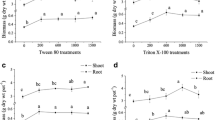Abstract
The chemical surfactant Tween 80 and biosurfactant rhamnolipid were respectively added to the composting substrate, a mixture of rice straw and bran, and their effects on the composting process were investigated. Samples were analysed for microbial communities of bacteria, actinomycetes and fungi, carboxymethylcellulose hydrolysis (CMCase) and xylanase activities, cellulose and hemicellulose fractions, water-soluble carbon (WSC) contents in the substrates, organic matter contents and pH values during the composting process. The results showed that both Tween 80 and rhamnolipid had slight stimulatory effects on the microbial populations of bacteria, actinomycetes and fungi. In addition, rhamnolipid increased the peak xylanase activity 15% higher than that of the control, while Tween 80 increased the maximum CMCase activity 35% higher than that of the control. As a result of the increased enzyme activities, treatments with Tween 80 and rhamnolipid were of higher WSC contents than the control during the whole composting process. Accordingly, the composting process was accelerated by the surfactants, since the organic matter was decomposed more quickly and the breakdown of cellulose and hemicellulose was better in the treatments with Tween 80 and rhamnolipid.
Similar content being viewed by others
References
Atkinson CF, Jones DD, Gauthier JJ (1996) Biodegradabilities and microbial activities during composting of municipal solid waste in bench-scale reactors. Compost Sci Util 4:14–23
Atkinson CF, Jones DD, Gauthier JJ (1997) Microbial activities during composting of pulp and paper-mill primary solids. World J Microbiol Biotechnol 13:519–525
Bolta SV, Mihelic R, Lobnic F, Lestan D (2003) Microbial community structure during composting with and without mass inocula. Compost Sci Util 11:6–15
Chantigny MH, Prévost D, Angers DA, Vézina LP, Chalifour F (1996) Microbial biomass and N transformations in two soils cropped with annual perennial species. Biol Fertil Soils 21:239–244
Charest MH, Antoun H, Beauchamp CJ (2004) Dynamics of water-soluble carbon substances and microbial populations during the composting of de-inking paper sludge. Bioresource Technol 91:53–67
Cotrufo MF, Ineson P, Roberts JD (1995) Decomposition of birch leaf litters with varying C-to-N ratios. Soil Biol Biochem 27:1219–1221
Eiland F, Klamer M, Lind A-M, Leth M, Bååth E (2001) Influence of initial C/N ratio on chemical and microbial composition during long term composting of straw. Microb Ecol 41:272–280
Eklind Y, Kirchmann H (2000) Composting and storage of organic household waste with different litter amendments. I: carbon turnover. Bioresource Technol 74:115–124
Eriksson T, Börjesson J, Tjerneld F (2002) Mechanism of surfactant effect in enzymatic hydrolysis of lignocellulose. Enzyme Microb Technol 31:353–364
Ghose TK (1987) Measurement of cellulase activities. Pure Appl Chem 59:257–268
Goering HK, Van Soest PJ (1970) Forage fiber analyses. In: USDA Agricultural Handbook 379, USDA, Washington, DC, pp 1–20
Goes AP, Sheppard JD (1999) Effect of surfactants on α-amylase production in a solid substrate fermentation process. J Chem Technol Biotechnol 74:709–712
Helle SS, Duff SJB, Cooper DG (1993) Effect of surfactants on cellulose hydrolysis. Biotechnol Bioeng 42:611–617
Johnsen AR, Karlson U (2004) Evaluation of bacterial strategies to promote the bioavailability of polycyclicaromatic hydrocarbons. Appl Microbiol Biotechnol 63:452–459
Laouar L, Bernard JM, Lowe KC (1992) Yeast permeabilization with surfactants. Biotechnol Lett 14:719–720
Mandviwala TN, Khire JM (2000) Production of high activity thermostable phytase from thermotolerant Aspergillus niger in solid state fermentation. J Ind Microbiol Biotechnol 24:237–243
Mulligan CN (2005) Environmental applications for biosurfactants. Environ Pollut 133:183–198
Mulligan CN, Yong RN, Gibbs BF, James S, Bennett HPJ (1999) Metal removal from contaminated soil and sediments by the biosurfactant surfactin. Environ Sci Technol 33:3812–3820
Pardo AG (1996) Effect of surfactants on cellulose production by Nectria catalinensis. Current Microbiol 33:275–278
Pérez J, Muňoz-Dorado J, Rubia T, Martínez J (2002) Biodegradation and biological treatments of cellulose, hemicellulose and lignin: an overview. Int Microbiol 5:53–63
Rahman KSM, Rahman TJ, Kourkoutas Y, Petsas I, Marchant R, Banat IM (2003) Enhanced bioremediation of n-alkane in petroleum sludge using bacterial consortium amended with rhamnolipid and micronutrients. Bioresource Technol 90:159–168
Reese ET, Manguire A (1969) Surfactants as stimulants of enzyme production by microorganisms. Appl Microbiol 17:242–245
Srivastava RAK, Baruah JN (1986) Culture conditions for production of thermostable amylase by Bacillus stearothermophilus. Appl Environ Microbiol 52:179–184
Tengerdy RP, Szakacs G (2003) Bioconversion of lignocellulose in solid substrate fermentation. Biochem Eng J 13:169–179
US EPA. Rhamnolipid biosurfactant (110029) Fact Sheet. 2005 http://www.epa.gov/oppbppd1/biopesticides/ingredients/factsheets/factsheet_110029.htm
Vuorinen AH (2000) Effect of bulking agent on acid and alkaline phosphomonoesterase and β-d-glucosidase activities during manure composting. Bioresource Technol 75:113–138
Zhang XF, Wang HT, Zhou HY, Zhang YA, Nie YF (2003) Co-composting of flower waste and cattle manure in pilot scale. Acta Scientiae Circumstantiae 23:360–365 (In Chinese)
Acknowledgements
This study was financially supported by the National 863 High Technology Research Program of China (2004AA649370) and the National Basic Research Program (973 Program) (No. 2005CB724203).
Author information
Authors and Affiliations
Corresponding author
Rights and permissions
About this article
Cite this article
Shi, JG., Zeng, GM., Yuan, XZ. et al. The stimulatory effects of surfactants on composting of waste rich in cellulose. World J Microbiol Biotechnol 22, 1121–1127 (2006). https://doi.org/10.1007/s11274-006-9152-2
Received:
Accepted:
Published:
Issue Date:
DOI: https://doi.org/10.1007/s11274-006-9152-2




